在中国落叶果树中,桃的栽培面积仅次于苹果、梨,居第3 位[1]。果实品质是决定果品商品价值的关键因素。在生产上,提高果实品质的技术包括套袋、施用外源物质和进行肥水管理等[2-4]。其中,外源植物激素处理是一项重要的提质增效技术[5]。
植物激素是一种植物自身生成的信号分子,能够在极低浓度下发挥作用,有无毒、高效且对环境友好的特点,在调控果实发育方面应用广泛。赤霉素是一种酸性二萜类化合物植物生长调节剂,参与种子萌发、茎干伸长、叶片扩展、花和果实发育等过程,其中GA3是一种生产上常用的活性赤霉素。在使用GA3调控果实生长发育方面,前人已在葡萄坐果[6]、苹果果实着色[7]和推迟桃果实成熟[8]等方面开展了研究。相关研究表明,采前叶面喷施GA3可以使桃果实体积增大[9-11],但质量浓度大于100 mg·L-1时,果实质量不再增加[12]。但也有研究发现在硬核期对桃树喷施GA3不能显著影响成熟果实的大小[13]。此外,喷施GA3还会使苹果果实拉长,影响外观品质和贮运特性[14-15]。外施GA3(GA 制剂)会推迟果实成熟,进而推迟或抑制果实成熟色泽的显现[16-18]。Ozkan 等[19]发现采前喷施GA3能够提高樱桃成熟期果实的果肉硬度。外施50、100 和150 mg·L-1 GA3显著提高椰枣果实的可溶性固形物含量[20]。此外,采前外施GA3(GAC)能够提高果实中可滴定酸和可溶性糖含量[21-22]。赵滨涛[23]研究表明,低需冷量桃品种的果实糖酸比显著低于中、高需冷量桃品种,果实总酸含量显著高于中、高需冷量桃品种,这可能与内源激素尤其是GA3的含量有关,还可能与果实所处的生长发育阶段相关[24]。因此,外源GA3可能对需冷量不同的桃果实品质影响有差异。目前,尚未见外源GA3对不同需冷量桃果实品质的影响报道。此外,在全球气候变暖及桃产业南延发展的背景下[25],低需冷量桃的花果管理技术研究也急需加强。多数低需冷量桃成花量高[26],可通过栽培技术手段调控花芽分化,进而减少疏花疏果方面的用工。笔者在本研究中拟以低、中、高需冷量桃为研究对象,探讨外源GA3对果实品质的影响,进而筛选适宜的外源GA3浓度。
1 材料和方法
1.1 材料与处理
试验于2023 年在江苏省农业科学院桃试验园进行。试验材料为DB2-9品系、霞晖8号和霞脆,各品种(系)桃物候期和需冷量如表1所示。树形为两主枝“Y”形,株行距2 m×5 m,南北行向,起垄栽培,生草覆盖,按常规方式进行田间土肥水管理和病虫害防治。
表1 不同桃品种(系)需冷量与物候期
Table 1 Chilling requirement and phenological period of different peach varieties(strains)

注:表中所示的日期为相应物候期的样品采集日期。
Note:The date shown in the table is the sample collection date of the corresponding phenological period.
品种(系)Variety(strain)需冷量Chilling requirement/h DB2-9霞晖8号Xiahui 8霞脆Xiacui取样时间(年-月-日)Sampling time(year-month-date)盛花期Blooming stage 2023-03-04 2023-03-11 2023-03-15成熟期Ripening stage 2023-06-12 2023-07-29 2023-07-05 200 546 606硬核期Hard core stage 2023-05-10 2023-06-03 2023-06-03膨大期Expansion stage 2023-05-18 2023-07-16 2023-06-20
根据预试验结果和物候期观测数据,在盛花后48、50 和46 d 分别对DB2-9、霞晖8 号和霞脆喷施GA3,喷施质量浓度均设为50(T2)、100(T3)、150(T4)mg·L-1,以喷施等量清水作为对照(T1)。喷施时以叶面滴液为度,每隔10 d 喷施1 次,共4次。每处理3株树,生长势一致,单株小区。
在每个品种(系)的果实硬核期、膨大期和成熟期采集果实样品,用于品质指标测定。样品采集时,每处理每树按东、西、南、北4个方位随机采取树体中上部无病虫害、无机械损伤的果实各10 个,迅速带回实验室,每处理随机选取20 个果实,用于相关指标的分析测定,3次生物学重复。测定完大小、单果质量、色差、硬度和可溶性固形物含量的果实用削皮器去皮,削取果肉,剁碎混匀,液氮速冻,置于-80 ℃冰箱保存,用于测定可溶性糖和有机酸含量。
1.2 指标测定
1.2.1 果实大小测定 用精确度为0.01 mm的电子数显卡尺(桂林广陆数字测控股份有限公司)测定果实纵径、横径,纵径和横径的比值即为果形指数。
1.2.2 单果质量测定 用分度值为0.1 g 的JA5003型电子天平(中国舜宇恒平公司)测定单果质量,以g表示。
1.2.3 色差测定 用ColorQuest XE 色差计(HunterLab,美国),采用Hunter Lab表色系统测定果实赤道部位4 个点的外果皮亮度值(L*)、红色饱和度(a*)及黄色饱和度(b*),并计算色饱和度(C),C=(a*2+b*2)1/2。
1.2.4 硬度测定 用TA.XT Plus质构仪(Stable Micro Systems,英国)测定果实缝合线两侧腹部的带皮硬度和去皮硬度,因不同生长发育期果实的硬度不同,硬核期和膨大期果实使用的探头直径为2 mm,成熟期果实使用的探头直径为8 mm,以利于探头贯入果实,测试深度5 mm,贯入速度1 mm·s-1[27],以N为单位。
1.2.5 可溶性固形物含量(SSC)测定 果实SSC用手持式便携数显折光仪PAL-1(ATAGO,Itabashiku,东京,日本)测定。测定位置为果实两侧腹部中果皮[27],以%为单位。
1.2.6 可溶性糖和有机酸含量测定 用高效液相色谱(Agilent 1260 infinity ii)测定果肉的蔗糖、葡萄糖、果糖、山梨醇、苹果酸、柠檬酸和奎尼酸含量,所用标准品均为色谱纯,购自Sigma公司。
可溶性糖含量的测定使用Transgenomic 的CARBOSep CHO-620 CA 柱(10 μm 粒径,6 mm×250 mm),流动相为ddH2O,双侧柱温80 ℃,使用VWD 检测器。有机酸含量的测定使用Agilent 的ZORBAX SB-Aq 柱(4.6 mm×250 mm ID,5 µm),RID 检测器,λ=214 nm。以上进样均3 次重复[28]。总糖含量=蔗糖含量+葡萄糖含量+果糖含量+山梨醇含量,总有机酸含量=苹果酸含量+柠檬酸含量+奎尼酸含量,以mg·g-1为单位。以总糖含量和总有机酸含量的比值计算糖酸比。
1.3 数据处理与分析
采用SPSS 22.0(SPSS Inc.,美国)进行方差分析。以LSD法分析不同处理间的差异显著性,采用Excel软件制图。
2 结果与分析
2.1 果实外在品质
2.1.1 果实质量 如图1 所示,不同质量浓度GA3处理的3个桃品种(系)的单果质量在硬核期已表现出差异,从硬核期至成熟期,各品种(系)果实的生长速率均存在差异。对于成熟期果实的单果质量,DB2-9 以T2、T3 处于较高水平且二者差异不显著,但显著高于T1、T4(图1-A);霞晖8 号和霞脆各处理果实的单果质量排序为T2>T3>T4>T1(p<0.05)(图1-B、C)。可见,不同质量浓度的GA3处理对不同品种(系)桃的单果质量有较大影响,外施50、100 mg·L-1 GA3可起到增大果个的作用,质量浓度过高则会延缓果实膨大速率。

图1 不同质量浓度外源GA3对不同需冷量桃单果质量的影响
Fig.1 Effects of different concentrations of exogenous GA3 on single fruit mass of peaches with different chilling requirements
2.1.2 果形指数 从图2 可知,外施不同质量浓度GA3对3个品种(系)膨大期果实的果形指数影响存在较大差异,而对DB2-9 和霞脆硬核期果实的果形指数无显著影响。对于成熟期果实的果形指数,DB2-9 处理间差异不显著(图2-A);霞晖8 号以T2处于最低水平(p<0.05),而其他处理差异不显著(图2-B);霞脆各处理排序为T1、T2>T3>T4(p<0.05)(图2-C)。可见,不同质量浓度GA3对不同品种(系)桃的果实形状影响不一,50 mg·L-1 GA3可显著降低霞晖8号成熟期的果形指数;100、150 mg·L-1 GA3可显著降低霞脆成熟期的果形指数。
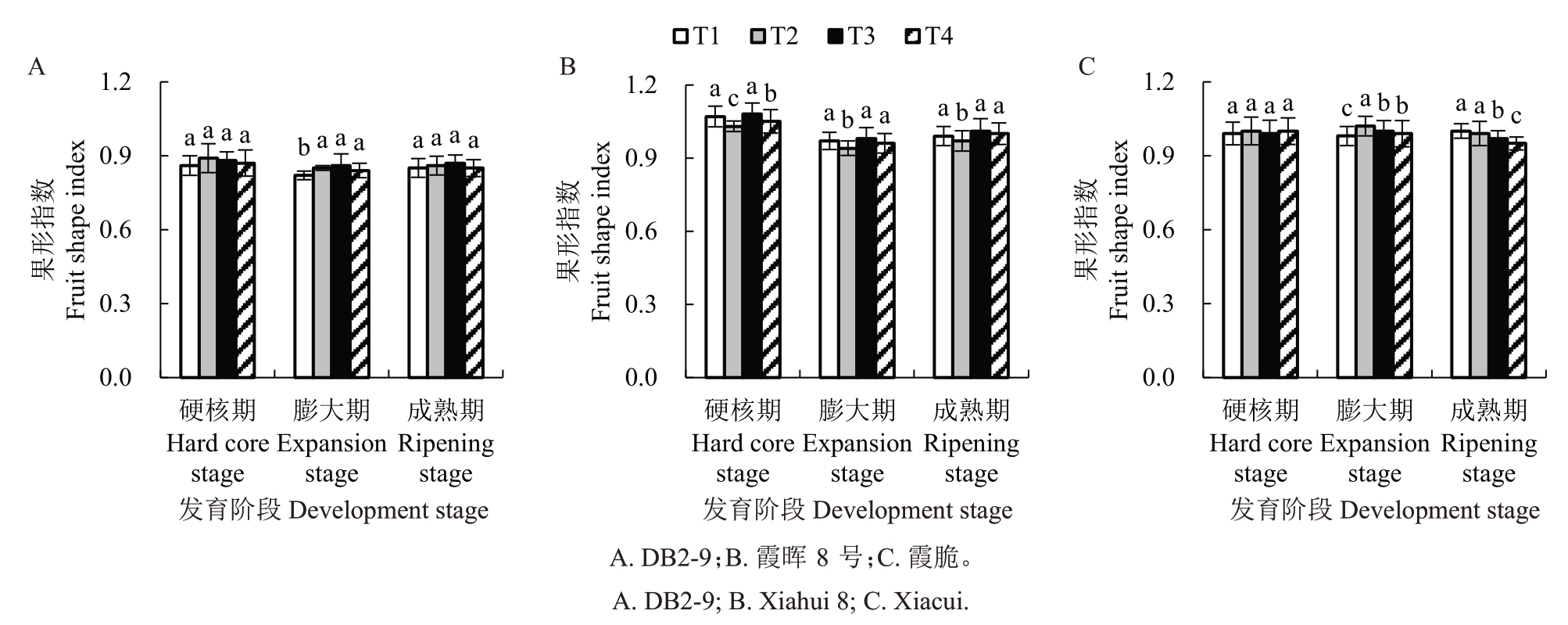
图2 不同质量浓度外源GA3对不同需冷量桃果形指数的影响
Fig.2 Effects of different concentrations of exogenous GA3 on fruit shape index of peaches with different chilling requirements
2.1.3 果实着色 图3 表明,不同质量浓度GA3对霞晖8 号和霞脆硬核期果实L*值无显著影响,对3个品种(系)膨大期L*值的影响不一。对于成熟期果实的L*值,DB2-9各处理间差异不显著(图3-A),霞晖8 号以T2 显著高于其他处理(图3-B),霞脆各处理排序为T1>T2>T4>T3(p<0.05)(图3-C)。
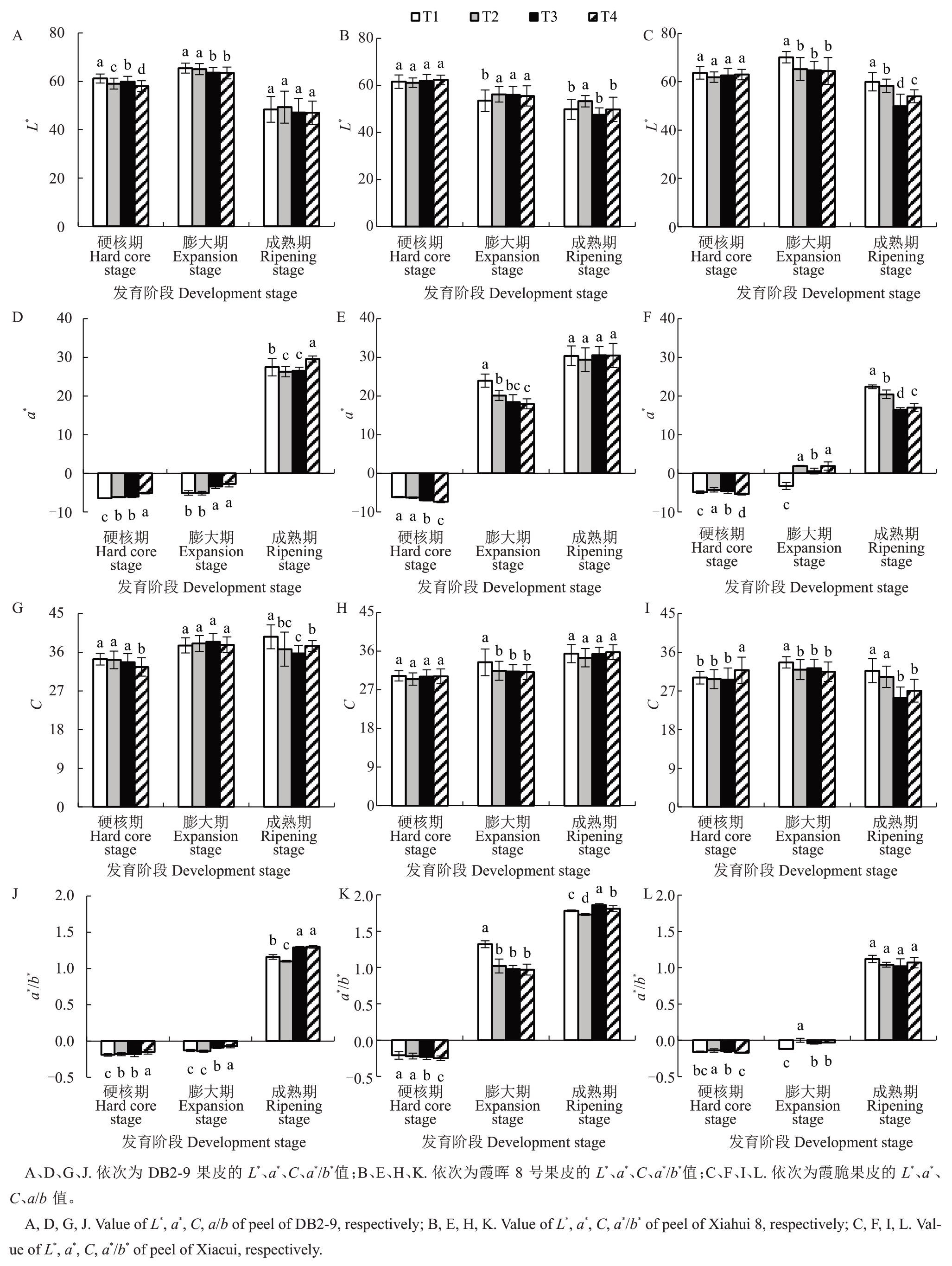
图3 不同质量浓度外源GA3对不同需冷量桃果皮色差的影响
Fig.3 Effects of different concentrations of exogenous GA3 on peel colour difference of peaches with different chilling requirements
不同质量浓度GA3对3个品种(系)的硬核期和膨大期果实a*值的影响有差异。对于硬核期果实的a*值,DB2-9和霞脆T3>T1(图3-D、F);霞晖8号T4 显著低于其他处理(p<0.05)(图3-E)。对于成熟期果实的a*值,DB2-9 各处理排序为T4>T1>T3、T2(p<0.05),霞晖8号各处理间无显著差异,霞脆各处理排序为T1>T2>T4>T3(p<0.05)。
DB2-9各处理在膨大期和霞晖8号各处理在硬核期果实C 值的差异不显著(图3-G、H);对于硬核期果实的C 值,DB2-9 的T4 显著低于其他处理;在膨大期,霞晖8号和霞脆T1显著高于其他处理(p<0.05)(图3-H、I)。对于成熟期果实的C 值,DB2-9和霞脆为T3、T4<T1(p<0.05),而霞晖8 号各处理间差异不显著。
外施不同质量浓度GA3对3个品种(系)果实a*/b*值的影响存在差异。在硬核期和膨大期,DB2-9 的T3、T4显著高于T1(图3-J);而对霞晖8号的影响相反(图3-K);霞脆T2 显著高于T1(p<0.05)(图3-L)。对于成熟期果实的a*/b*值,DB2-9 和霞晖8 号各处理排序为T4、T3>T1>T2(p<0.05);霞脆各处理间差异不显著。
总体上看,与对照(T1)相比,外施150 mg·L-1 GA3有利于DB2-9 成熟期果实着色,不同质量浓度GA3对霞晖8 号成熟期果实的色泽影响较小,高质量浓度GA3不利于霞脆成熟期果实着色。
2.2 果实内在品质
2.2.1 硬度 由图4 可知,不同质量浓度GA3处理的3个桃品种(系)的带皮硬度在硬核期已表现出差异,从硬核期至成熟期,各品种(系)果实的硬度降低速率也不相同。对于成熟期果实的带皮硬度,DB2-9各处理间无显著差异(图4-A);霞晖8号各处理排序为T4、T1>T2、T3(p<0.05)(图4-C);霞脆为T3、T4>T2、T1(p<0.05)(图4-E)。
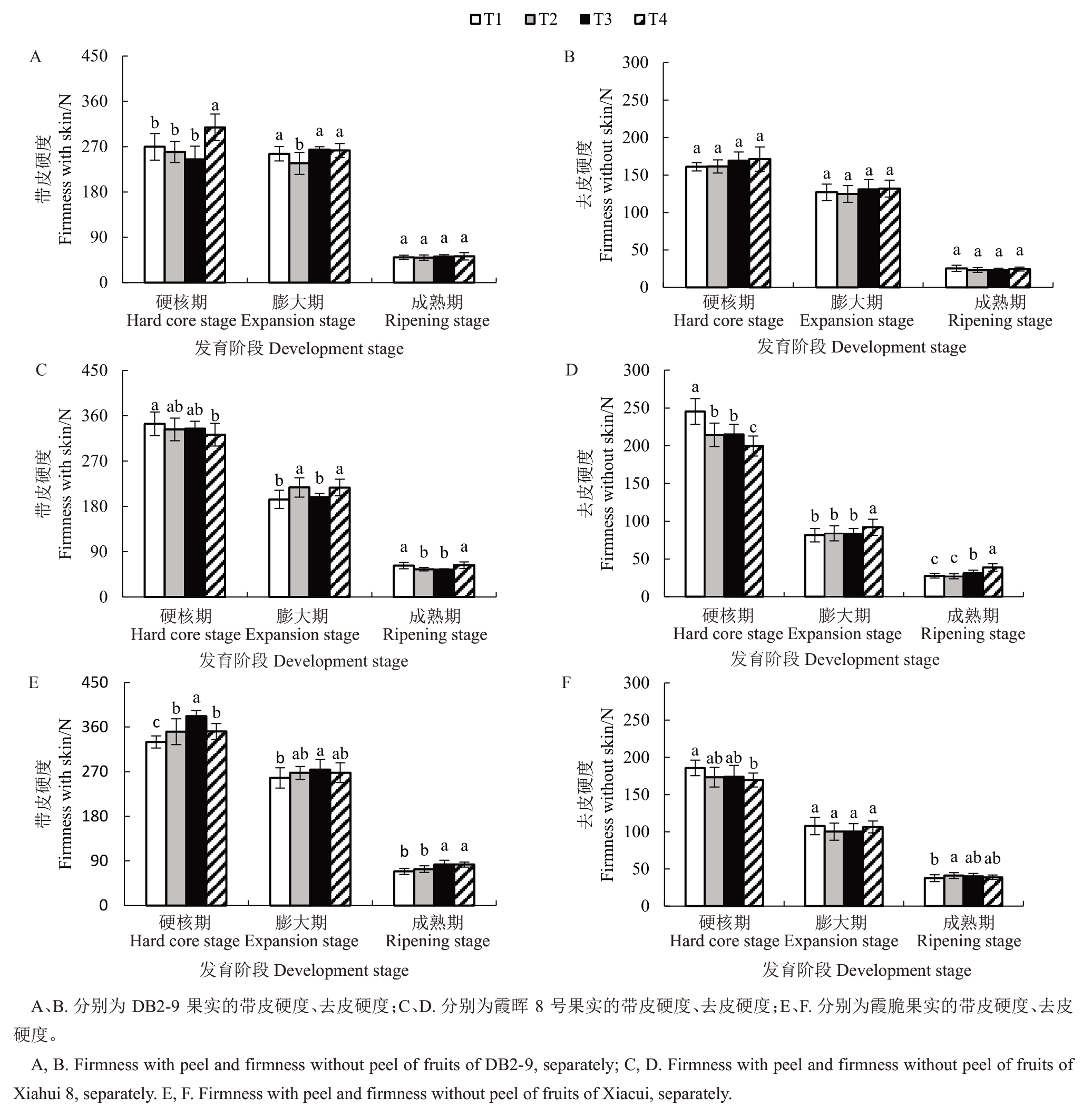
图4 不同质量浓度外源GA3对不同需冷量桃果实硬度的影响
Fig.4 Effect of different concentrations of exogenous GA3 on fruit firmness of peaches with different chilling requirements
外施GA3对霞晖8号和霞脆硬核期和成熟期果实的去皮硬度影响较大。对于3个品种(系)成熟期果实的去皮硬度,DB2-9各处理间无显著差异(图4-B);霞晖8 号各处理排序为T4>T3>T1、T2(p<0.05)(图4-D);霞脆T2>T1(p<0.05),T3、T4 处理的去皮硬度略低于T2,差异不显著(图4-F)。可见,不同质量浓度GA3对不同品种(系)桃的果实硬度影响不一,与对照(T1)相比,100 和150 mg·L-1 GA3处理可提高霞晖8号成熟期的去皮硬度和霞脆成熟期的果实硬度;3 种质量浓度的GA3对DB2-9 成熟期的果实硬度无显著影响。
2.2.2 可溶性固形物含量 如图5所示,不同质量浓度外源GA3能提高DB2-9在3个时期果实的可溶性固形物含量(SSC),霞晖8 号和霞脆各处理下果实SSC的变化趋势均存在差异。对于3个品种(系)成熟期果实的SSC,DB2-9各处理排序为T4、T3>T2>T1(p<0.05)(图5-A);霞晖8 号为T2>T4>T3>T1(p<0.05)(图5-B);霞脆T4处理显著高于其他处理(图5-C)。由此可知,与对照(T1)相比,150 mg·L-1 GA3均能显著提高3个品种(系)成熟期果实的SSC。
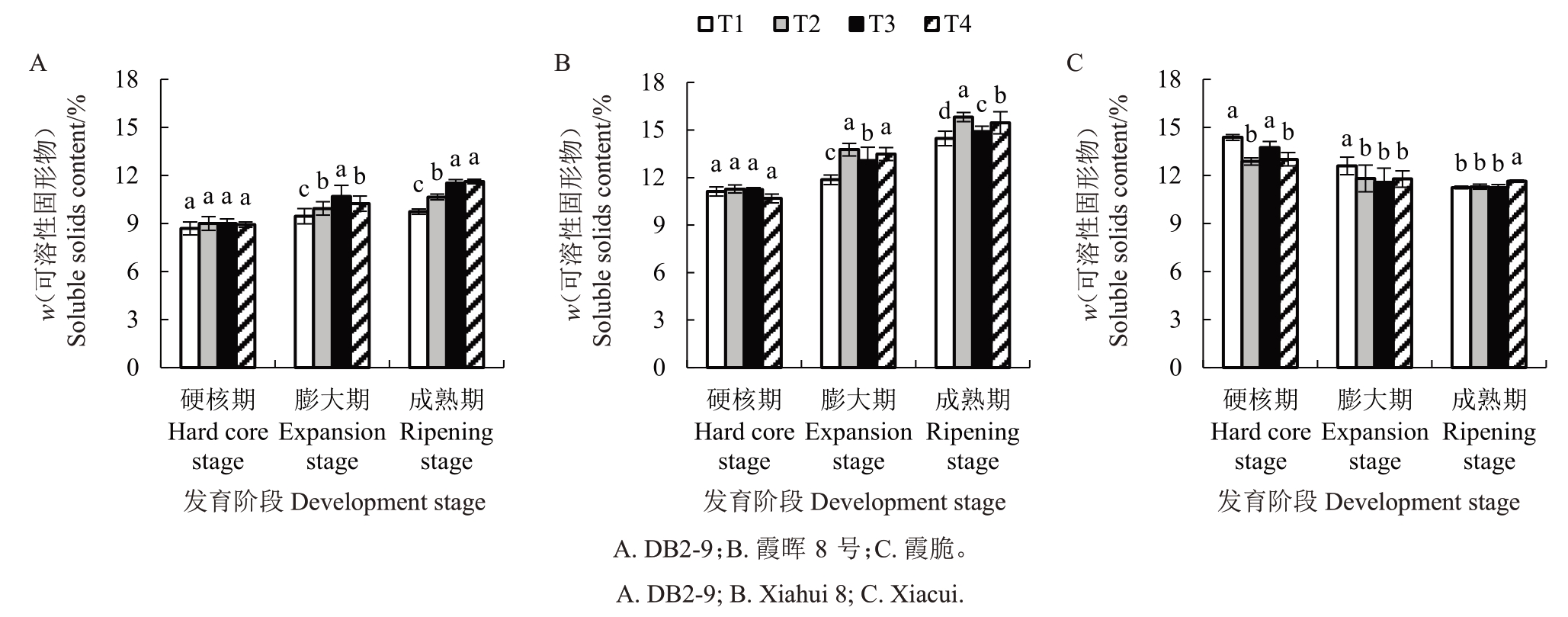
图5 不同质量浓度外源GA3对不同需冷量桃果实可溶性固形物含量的影响
Fig.5 Effects of different concentrations of exogenous GA3 on soluble solids content of peach fruits with different chilling requirements
2.3 糖酸组分含量
2.3.1 可溶性糖含量 图6表明,不同质量浓度GA3对3个桃品种(系)果实的蔗糖含量影响明显,在3个时期内,各品种(系)不同处理间的变化趋势不尽相同。对于成熟期果实的蔗糖含量,DB2-9各处理排序为T3、T4>T2>T1(p<0.05)(图6-A);霞晖8 号T2处理显著高于其他处理(p<0.05)(图6-B);霞脆T3处理显著低于T1、T2和T4(p<0.05)(图6-C)。

图6 不同质量浓度外源GA3对不同需冷量桃果实可溶性糖含量的影响
Fig.6 Effects of different concentrations of exogenous GA3 on soluble sugar content of peach fruits with different chilling requirements
从硬核期至成熟期,不同质量浓度GA3处理的3个品种(系)果实的葡萄糖含量变化趋势有所不同。对于硬核期和膨大期果实的葡萄糖含量,DB2-9的3种质量浓度GA3处理组均高于T1(图6-D);而霞脆与之相反(图6-F)。对于成熟期果实的葡萄糖含量,DB2-9 各处理组排序为T3>T4、T2>T1(p<0.05);霞晖8号和霞脆各处理间差异不显著(图6-E、F)。
不同质量浓度GA3处理的3个品种(系)果实的果糖含量变化趋势差异较大,对硬核期和膨大期果实的果糖含量影响显著。对于成熟期果实的果糖含量,DB2-9 各处理排序为T4、T3>T2>T1(p<0.05)(图6-G);霞晖8 号和霞脆各处理间差异不显著(图6-H、I)。
不同质量浓度外施GA3显著降低了3 个品种(系)硬核期果实的山梨醇含量,对各品种(系)膨大期果实的山梨醇含量也有较显著的影响。对于成熟期果实的山梨醇含量,3个品种(系)的3种质量浓度GA3处理组均显著高于T1(p<0.05)(图6-J、K、L)。
不同质量浓度外源GA3对3个品种(系)硬核期和膨大期果实总糖含量的影响不一。对于成熟期果实的总糖含量,DB2-9 各处理排序为T3、T4>T2>T1(p<0.05)(图6-M);霞晖8 号为T2、T3>T4、T1(p<0.05)(图6-N);霞脆各处理间差异不显著(图6-O)。
综上所述,50、100 mg·L-1 GA3 能显著提高DB2-9和霞晖8号成熟期果实的可溶性糖含量,3种质量浓度的GA3对霞脆成熟期果实可溶性总糖含量的影响不显著。
2.3.2 有机酸含量 通过对3个品种(系)果实有机酸含量变化的分析,发现不同质量浓度GA3处理的3个品种(系)果实的奎尼酸含量降低速率存在差异(图7)。对于成熟期果实的奎尼酸含量,DB2-9 各处理排序为T3、T4>T2>T1(p<0.05)(图7-A);霞晖8 号T4 处理显著高于其他处理(图7-B);霞脆T3处理显著高于其他处理(图7-C)。
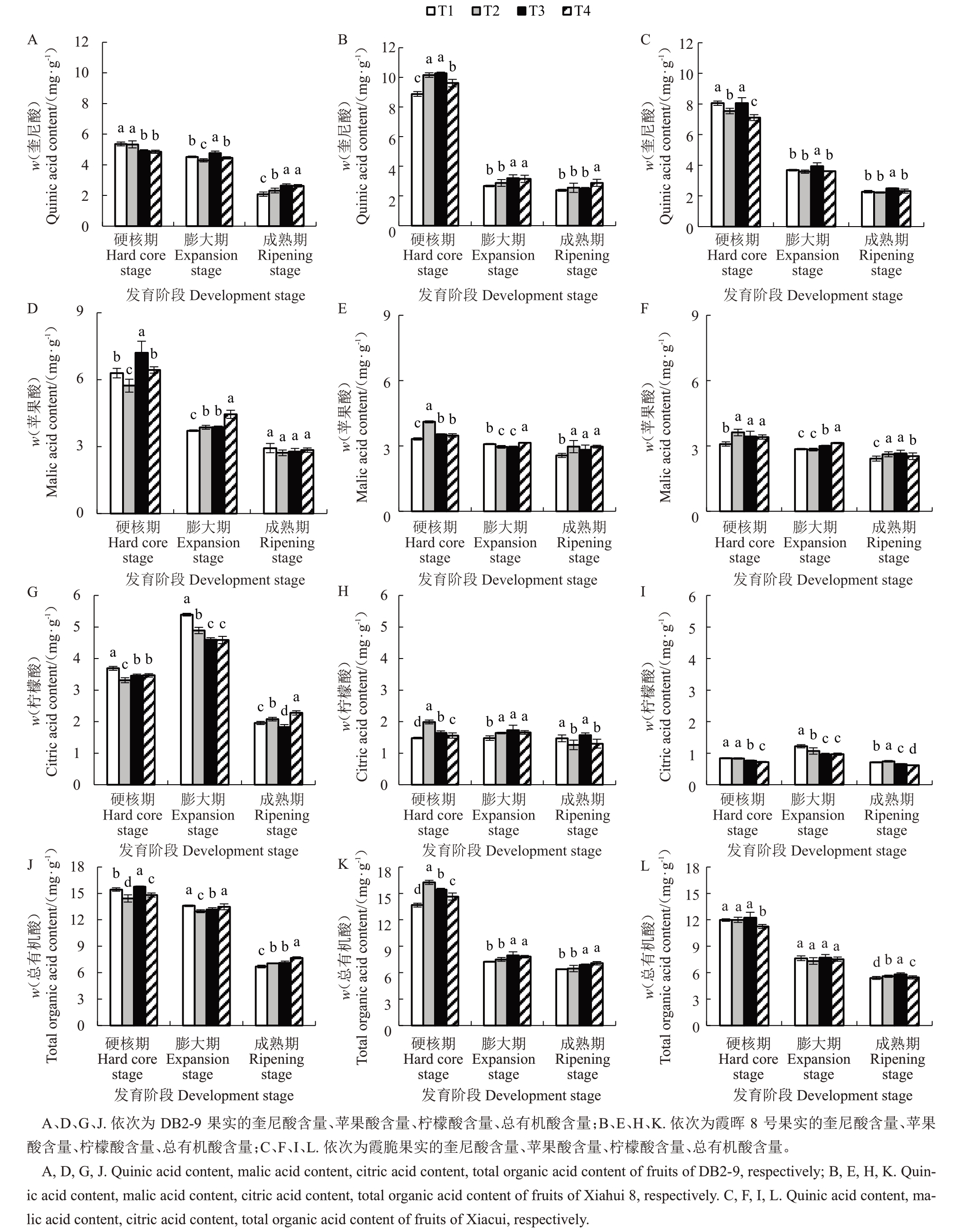
图7 不同质量浓度外源GA3对不同需冷量桃果实有机酸含量的影响
Fig.7 Effects of different concentrations of exogenous GA3 on organic acid content in peach fruits with different chilling requirements
外施不同质量浓度GA3对3个品种(系)硬核期果实苹果酸含量的影响存在显著差异。膨大期各品种(系)T4 处理的苹果酸含量均最高(p<0.05)。对于成熟期果实的苹果酸含量,DB2-9 各处理间差异不显著(图7-D);霞晖8 号和霞脆的T1 处理均显著低于其他处理(p<0.05)(图7-E、F)。
从硬核期至成熟期,不同质量浓度GA3处理的3 个品种(系)果实柠檬酸含量变化趋势存在差异。对于成熟期果实的柠檬酸含量,DB2-9 各处理排序为T4>T2>T1>T3(p<0.05)(图7-G);霞晖8号为T3、T1>T4、T2(p<0.05)(图7-H);霞脆为T2>T1>T3>T4(p<0.05)(图7-I)。
从硬核期到成熟期,不同质量浓度GA3处理的3 个品种(系)果实总有机酸含量降低速率有所差异。对于成熟期果实的总有机酸含量,DB2-9 各处理排序为T4>T3、T2>T1(p<0.05)(图7-J);霞晖8 号为T4、T3>T2、T1(p<0.05)(图7-K);霞脆为T3>T2>T4>T1(p<0.05)(图7-L)。可见,外源喷施50~150 mg·L-1 GA3可提高3 个桃品种(系)成熟期果实中的有机酸含量。
2.3.3 糖酸比 如图8所示,不同质量浓度GA3处理的3个品种(系)从硬核期至成熟期果实糖酸比增长速率不尽相同。对于成熟期果实的糖酸比,DB2-9的T3处理显著高于其他处理(图8-A);霞晖8号各处理间差异不显著(图8-B);霞脆各处理排序为T4、T1>T2>T3(p<0.05)(图8-C)。外施50~150 mg·L-1 GA3可提高DB2-9 膨大期和成熟期果实的糖酸比,而外施50和100 mg·L-1 GA3可降低霞晖8号和霞脆硬核期和膨大期果实的糖酸比。
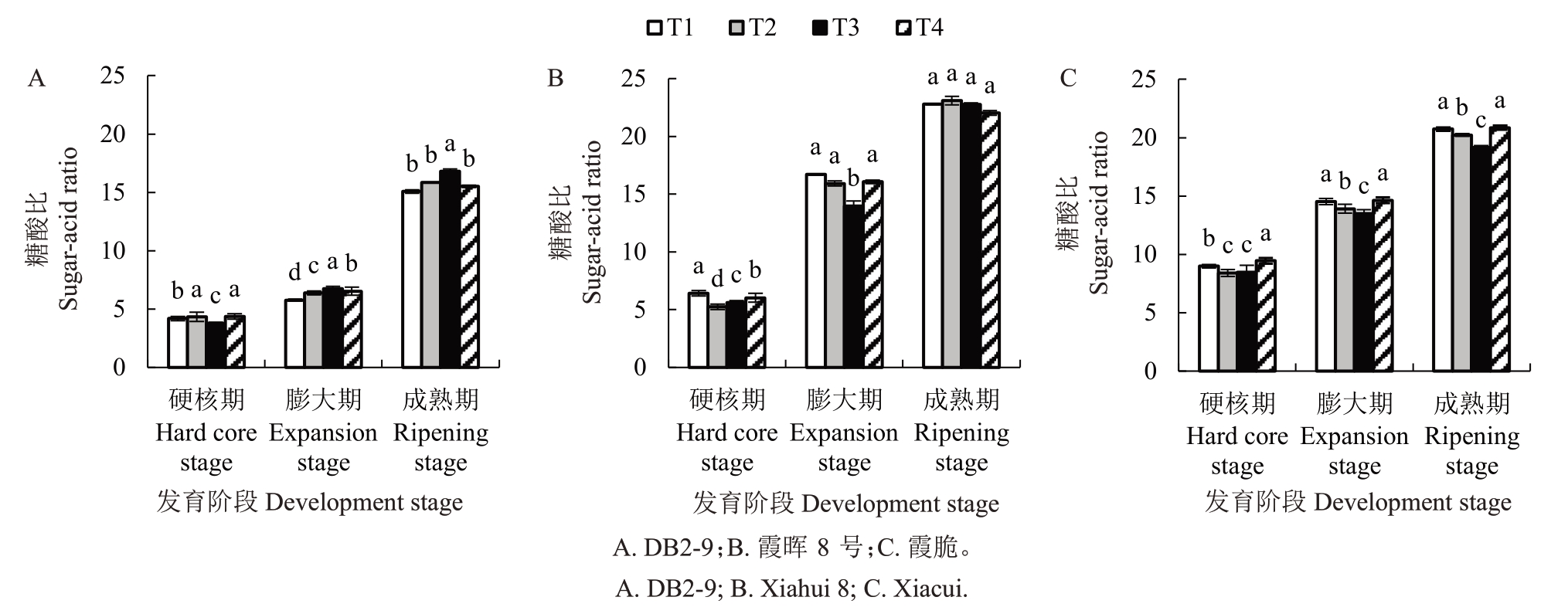
图8 不同质量浓度外源GA3对不同需冷量桃果实糖酸比的影响
Fig.8 Effects of different concentrations of exogenous GA3 on sugar-acid ratio of peach fruits with different chilling requirements
3 讨 论
3.1 不同品种(系)桃果实外观品质受外源GA3调控
在桃生产过程中,提高果实综合品质是一个关键环节。而外源赤霉素在调控果实发育和提高果实品质方面有着重要作用[29]。前人研究发现外源赤霉素对果实大小、形状、单果质量、色泽、硬度和糖酸含量等方面均有影响[30-32]。GA3能够提高与细胞壁松弛的相关酶活性[33],并提高参与细胞伸长生长相关基因的转录水平[34],从而使得果实增大并拉长。赤霉素可以通过激活糖代谢相关酶而调控源库关系及库容量,从而提高果实质量[35-37]。外施50 mg·L-1 GA3使兔眼蓝莓成熟果实纵径和横径显著增加,且提高了果实的果形指数[38]。Li 等[39]研究表明,外施1.25 mmol·L-1 GA4+7能够提高桃的单果质量。笔者在本研究中发现,外施GA3对霞晖8 号和霞脆3 个时期单果质量的影响与Li等[39]研究结果一致,但外施100、150 mg·L-1 GA3会降低DB2-9在硬核期和膨大期果实的单果质量。外施GA3会抑制桃花芽分化[40],且低需冷量桃品种花芽开始分化的时间较中、高需冷量桃品种早[41]。本研究中有关外源GA3对不同需冷量桃成花的影响与前人研究结果一致。因此,推测外源GA3影响了DB2-9 早期花芽的发育,导致植物营养分配紊乱,同化物从叶片向果实的运输受阻,影响了低需冷量桃果实的前期发育。此外,外源GA3能显著提高DB2-9 在膨大期果实的果形指数,这与前人的研究结果一致[34],而外施50 mg·L-1 GA3处理的霞晖8号3个时期和不同质量浓度外源GA3处理的霞脆成熟期果实的果形指数与前人[34]的研究结果不一致。不同蓝莓品种果实的形状差异与果实在发育过程前期的平周分裂和中后期的垂周分裂有关,垂周分裂持续的时间越长则果形指数越大[42]。DB2-9果实由硬核期发育至膨大期的时间较短,推测外源GA3通过促进DB2-9 果实细胞的垂周分裂而提高果形指数。霞晖8号和霞脆果实发育过程中硬核期更长,推测外源GA3能够促进霞晖8号和霞脆果实细胞的平周分裂而降低果形指数。
施加外源GA3会抑制果实类胡萝卜素的合成,不利于果实的着色[43]。张颖[44]研究表明外施GA3不利于成熟期桃果实红色的显现,且外施浓度越高,a*值和b*值越小。还有研究表明,喷施赤霉素不能显著改变桃成熟期果实的色泽[45]。笔者在本研究中的结果表明,外源GA3对霞脆桃成熟期果实着色也具有抑制效应,且这种作用随需冷量的升高而增强。在樱桃转色期(35 DAFB)外施GA3会延迟中熟品种成熟色泽的显现,而降低了早熟品种成熟果实的IAD;外源GA3抑制了早熟樱桃品种UFGTs基因的转录上调,而促进了中熟品种ANR 基因的表达[46]。推测外源GA3对不同需冷量桃品种(系)也存在相似的影响。糖是花青素苷合成的底物,并作为花青素苷合成的能量来源[47]。不同浓度外源GA3能提高DB2-9和霞晖8号成熟期果实的总糖含量。推测外源GA3促进低、中需冷量桃成熟期果实的可溶性糖积累,因此减弱了外源GA3对成熟期果实着色的抑制作用。
3.2 不同品种(系)桃果实内在品质对外源GA3施用反应的敏感性不同
前人有关外源GA3对果实发育和品质的影响研究多集中在成熟期,而缺乏对果实生长发育期的研究。研究发现,外源GA3处理能提高果实的细胞壁与细胞体积比,增加果实细胞壁物质,增大细胞壁中纤维素的比例[45,48],提高果实的硬度。Kuhn等[46]的研究表明,在樱桃转色期(S2 期)喷施GA3能够提高早熟及中熟樱桃品种成熟果实的硬度。笔者在本研究中发现,外源GA3对DB2-9 成熟期果实硬度无显著影响,而外施150 mg·L-1 GA3能够提高霞脆膨大期和成熟期的果实硬度。硬质桃在成熟期生长素(IAA)合成受阻导致乙烯不能正常释放[49],且外施GA3能降低樱桃果实发育过程中果实的IAA含量[50]。推测外施150 mg·L-1 GA3能抑制霞脆桃成熟期乙烯的释放,且这种作用对霞脆较DB2-9 强,造成了外源GA3对两个品种(系)成熟期果实硬度的不同影响。
采前外施GA3能够提高兔眼蓝莓果实的SSC[51]。本研究结果表明,外施GA3能提高DB2-9 和霞晖8号膨大期和成熟期果实的SSC,外施150 mg·L-1 GA3的霞脆成熟期果实SSC 显著高于其他各处理。本研究结果与前人的研究较一致。外源GA3能够提高果实库强,并提高果实中SDH 和SS 等糖代谢相关酶活性,从而提高果实中可溶性糖含量[52]。前人研究发现,对果树喷施GA3在提高成熟期果实可溶性糖含量的同时也会提高有机酸的含量[52-53]。一方面,外施GA3提高了DB2-9和霞晖8号成熟期果实总糖含量及3个品种(系)成熟期果实总有机酸含量,这与前人的研究结果一致。另一方面,在硬核期,3个品种(系)外施50、100 mg·L-1 GA3下果实的总糖含量低于对照(T1)、150 mg·L-1 GA3。同化物在苹果新梢速生期主要分配给新生的枝条和叶片[54],且较低浓度GA3能够促进果树的新梢生长[55],推测外源GA3抑制了同化物在硬核期向桃果实的运输,从而降低了果实的总糖含量。外施100、150 mg·L-1 GA3能显著提高3个品种(系)成熟期果实的总有机酸含量,这与前人的研究结果一致。外施GA3对3个品种(系)成熟期果实的糖酸比影响较小,这与外源GA3既能提高果实的可溶性糖含量又能提高有机酸含量有关。
4 结 论
不同桃品种(系)对外源GA3的响应不同,一定质量浓度的外源GA3能够显著提升不同桃品种(系)成熟期果实外观及内在品质(单果质量、总糖含量等)。DB2-9、霞晖8 号和霞脆的适宜外施GA3质量浓度分别为100、50和50 mg·L-1,研究结果将为外源GA3应用于桃果实品质提升方面提供理论依据和实际参考。
[1] 张斌斌,马瑞娟,宋宏峰,郭磊,俞明亮.江苏省桃产业现状与发展对策[J].落叶果树,2021,53(6):30-33.ZHANG Binbin,MA Ruijuan,SONG Hongfeng,GUO Lei,YU Mingliang. Current situation and development countermeasures of peach industry in Jiangsu Province[J]. Deciduous Fruits,2021,53(6):30-33.
[2] GAO C C,ZHANG Y,LI H M,GAO Q,CHENG Y D,OGUNYEMI S O,GUAN J F.Fruit bagging reduces the postharvest decay and alters the diversity of fruit surface fungal community in‘Yali’pear[J].BMC Microbiology,2022,22(1):239.
[3] 郭磊,张斌斌,马瑞娟,宋宏峰,蔡志翔.5-氨基乙酰丙酸处理对桃果实品质及营养生长的影响[J].江苏农业科学,2015,43(12):194-196.GUO Lei,ZHANG Binbin,MA Ruijuan,SONG Hongfeng,CAI Zhixiang. Effects of 5-aminolevulinic acid treatment on fruit quality and vegetative growth of peach fruit[J]. Jiangsu Agricultural Sciences,2015,43(12):194-196.
[4] WANG L,LI J,YANG F,YAOYAO E,RAZA W,HUANG Q W,SHEN Q R.Application of bioorganic fertilizer significantly increased apple yields and shaped bacterial community structure in orchard soil[J].Microbial Ecology,2017,73(2):404-416.
[5] 郑奇志.植物生长调节剂对上海地区甜樱桃坐果率及果实品质的影响[D].上海:上海交通大学,2019.ZHENG Qizhi. Effects of plant growth regulators on fruit setting rate and fruit quality of sweet cherry in Shanghai[D].Shanghai:Shanghai Jiao Tong University,2019.
[6] LU L,LIANG J J,CHANG X,YANG H T,LI T Z,HU J F.Enhanced vacuolar invertase activity and capability for carbohydrate import in GA- treated inflorescence correlate with increased fruit set in grapevine[J]. Tree Genetics & Genomes,2017,13(1):21.
[7] 段诗瑶.GA 与MeJA 调控苹果果实着色的关键基因筛选和功能初探[D].北京:北京农学院,2023.DUAN Shiyao.Screening and function analysis of key genes for regulate of GA and MeJA induced apple fruit coloring[D]. Beijing:Beijing University of Agriculture,2023.
[8] AMARANTE C V T DO,DREHMER A M F,SOUZA F D,FRANCESCATTO P. Preharvest spraying with gibberellic acid(GA3) and aminoethoxyvinilglycine (AVG) delays fruit maturity and reduces fruit losses on peaches[J].Revista Brasileira de Fruticultura,2005,27(1):1-5.
[9] ZILKAH S,LURIE S,LAPSKER Z,ZUTHI Y,DAVID I,YESSELSON Y,ANTMAN S,BEN ARIE R.The ripening and storage quality of nectarine fruits in response to preharvest application of gibberellic acid[J]. Journal of Horticultural Science,1997,72(3):355-362.
[10] MARTÍNEZ- ROMERO D,VALERO D,SERRANO M,BURLÓ F,CARBONELL A,BURGOS L,RIQUELME F. Exogenous polyamines and gibberellic acid effects on peach(Prunus persica L.) storability improvement[J]. Journal of Food Science,2000,65(2):288-294.
[11] STERN R A,BEN-ARIE R. GA3 inhibits flowering,reduces hand-thinning,and increases fruit size in peach and nectarine[J].The Journal of Horticultural Science and Biotechnology,2009,84(2):119-124.
[12] JU Z G,DUAN Y S,JU Z Q.Combinations of GA3 and AVG delay fruit maturation,increase fruit size and improve storage life of‘Feicheng’peaches[J]. The Journal of Horticultural Science and Biotechnology,1999,74(5):579-583.
[13] DAGAR A,WEKSLER A,FRIEDMAN H,LURIE S.Gibberellic acid (GA3) application at the end of pit ripening:Effect on ripening and storage of two harvests of‘September Snow’peach[J].Scientia Horticulturae,2012,140:125-130.
[14] 路侠. 不同浓度赤霉素(GA3)对‘嘎拉’苹果果形的影响[D].泰安:山东农业大学,2023.LU Xia.Effect of different concentration of gibberellin(GA3)on fruit shape of‘Gala’apple [D]. Taian:Shandong Agricultural University,2023.
[15] 郑柯斌,司文,杨怡妍,林海,陈杰,袁静.3 种赤霉素对蓝莓果实成熟与品质的影响[J].浙江农业科学,2020,61(3):524-527.ZHENG Kebin,SI Wen,YANG Yiyan,LIN Hai,CHEN Jie,YUAN Jing. Effects of three gibberellins on ripening and quality of blueberry[J]. Journal of Zhejiang Agricultural Sciences,2020,61(3):524-527.
[16] YANG H Y,LI J Z,LI X H,WU R,ZHANG X L,FAN X G,LI G T,GONG H S,YIN X R,ZHANG A D. The mechanism of gibberellins treatment suppressing kiwifruit postharvest ripening processes by transcriptome analysis[J]. Postharvest Biology and Technology,2023,198:112223.
[17] SU D,LIU K D,YU Z S,LI Y,ZHANG Y X,ZHU Y Q,WU Y,HE H Y,ZENG X D,CHEN H L,GRIERSON D,DENG H,LIU M C. Genome-wide characterization of the tomato GASA family identifies SlGASA1 as a repressor of fruit ripening[J].Horticulture Research,2022,10(1):uhac222.
[18] SOUTHWICK S M,YEAGER J T. Use of gibberellin formulations for improved fruit firmness and chemical thinning in‘Patterson’apricot[J].Acta Horticulturae,1995(384):425-430.
[19] OZKAN Y,UCAR M,YILDIZ K,OZTURK B.Pre-harvest gibberellic acid (GA3) treatments play an important role on bioactive compounds and fruit quality of sweet cherry cultivars[J].Scientia Horticulturae,2016,211:358-362.
[20] AWAD M A,AL-QURASHI A D. Gibberellic acid spray and bunch bagging increase bunch weight and improve fruit quality of‘Barhee’date palm cultivar under hot arid conditions[J].Scientia Horticulturae,2012,138:96-100.
[21] DOMINGOS S,NOBREGA H,RAPOSO A,CARDOSO V,SOARES I,RAMALHO J C,LEITÃO A E,OLIVEIRA C M,GOULAO L F. Light management and gibberellic acid spraying as thinning methods in seedless table grapes (Vitis vinifera L.):Cultivar responses and effects on the fruit quality[J]. Scientia Horticulturae,2016,201:68-77.
[22] FAMIANI F,PROIETTI P,PILLI M,BATTISTELLI A,MOSCATELLO S. Effects of application of thidiazuron (TDZ),gibberellic acid (GA3),and 2,4-dichlorophenoxyacetic acid (2,4-D)on fruit size and quality of Actinidia deliciosa‘Hayward’[J].New Zealand Journal of Crop and Horticultural Science,2007,35(3):341-347.
[23] 赵滨涛.桃需冷量预估模型和低需冷量桃表型研究[D].南京:南京农业大学,2023.ZHAO Bintao. Prediction model of peach chilling requirement and phenotypic study of low chilling requirement peaches[D].Nanjing:Nanjing Agricultural University,2023.
[24] FENN M A,GIOVANNONI J J. Phytohormones in fruit development and maturation[J].The Plant Journal,2021,105(2):446-458.
[25] 严娟,赵滨涛,孙朦,宋宏峰,蔡志翔,李垍峣,宿子文,张明昊,沈志军,许建兰,马瑞娟,俞明亮.基于桃需冷量探讨气温变化对其适应性的挑战[J].园艺学报,2023,50(4):724-736.YAN Juan,ZHAO Bintao,SUN Meng,SONG Hongfeng,CAI Zhixiang,LI Jiyao,SU Ziwen,ZHANG Minghao,SHEN Zhijun,XU Jianlan,MA Ruijuan,YU Mingliang. Adaptability of peach under air temperature change based on chilling requirement[J].Acta Horticulturae Sinica,2023,50(4):724-736.
[26] 王力荣,朱更瑞,方伟超,曹珂,陈昌文,王新卫,李勇,吴金龙.桃低需冷量种质发掘、创新与利用:中国农业科学院郑州果树研究所研究进展[J].果树学报,2022,39(7):1295-1307.WANG Lirong,ZHU Gengrui,FANG Weichao,CAO Ke,CHEN Changwen,WANG Xinwei,LI Yong,WU Jinlong. Advance in research on exploration,improvement and utilization of low chilling requirement germplasm resources in peach and nectarine:Progress of Zhengzhou Fruit Research Institute,Chinese Academy of Agricultural Sciences[J]. Journal of Fruit Science,2022,39(7):1295-1307.
[27] ZHANG B B,GUO J Y,MA R J,CAI Z X,YAN J,ZHANG C H. Relationship between the bagging microenvironment and fruit quality in‘Guibao’peach [Prunus persica (L.) Batsch][J].The Journal of Horticultural Science and Biotechnology,2015,90(3):303-310.
[28] 沈志军,马瑞娟,俞明亮,蔡志翔,宋宏峰,李晓.桃果实发育过程中主要糖及有机酸含量的变化分析[J]. 华北农学报,2007,22(6):130-134.SHEN Zhijun,MA Ruijuan,YU Mingliang,CAI Zhixiang,SONG Hongfeng,LI Xiao. Regularity analysis of main sugar and acid in fruit development of peach[J].Acta Agriculturae Boreali-Sinica,2007,22(6):130-134.
[29] 周宇,佟兆国,张开春,闫国华.赤霉素在落叶果树生产中的应用[J].中国农业科技导报,2006,8(2):27-31.ZHOU Yu,TONG Zhaoguo,ZHANG Kaichun,YAN Guohua.Application of gibberellin to production of deciduous fruit crops[J].Journal of Agricultural Science and Technology,2006,8(2):27-31.
[30] 王弋,董晨,魏永赞,郑雪文,李伟才.GA 信号途径及其调控果树生长发育的研究进展[J]. 果树学报,2018,35(4):500-511.WANG Yi,DONG Chen,WEI Yongzan,ZHENG Xuewen,LI Weicai. Research progress on GA signaling pathway and its function in regulating fruit trees growth and development[J].Journal of Fruit Science,2018,35(4):500-511.
[31] 汤红.外源GA3和乙烯对芒果色泽变化的影响及其转录调控分析[D].海口:海南大学,2020.TANG Hong.Analysis of the effects of exogenous GA3 and ethylene on color change of mango and its transcriptional regulation[D].Haikou:Hainan University,2020.
[32] 陈静,秦栋,杨新雨,张鹏,迟睿,张利军,冮慧欣,霍俊伟.不同植物生长调节物质对蓝果忍冬果实脱落及果实品质的影响[J].果树学报,2022,39(11):2113-2123.CHEN Jing,QIN Dong,YANG Xinyu,ZHANG Peng,CHI Rui,ZHANG Lijun,GANG Huixin,HUO Junwei. Effects of different plant growth regulators on abscission and quality of Lonicera caerulea Berel fruit[J].Journal of Fruit Science,2022,39(11):2113-2123.
[33] 杨塞,肖层林.赤霉素的生物合成及促进水稻茎伸长机理研究进展[J].作物研究,2004,18(增刊1):317-320.YANG Sai,XIAO Cenglin. Research progress on the biosynthesis of gibberellin and its mechanism of promoting stem elongation in rice[J].Crop Research,2004,18(Suppl.1):317-320.
[34] XUE Z Y,YANG R,WANG Y D,MA Y C,LIN Y J,LI Z G,SONG Y Q,FENG X X,LI L L.Candidate gene mining of GAmediated regulation of pear fruit shape[J].Horticulture,Environment,and Biotechnology,2024,65(3):403-412.
[35] LI Y H,WU Y J,WU B,ZOU M H,ZHANG Z,SUN G M.Exogenous gibberellic acid increases the fruit weight of‘Comte de Paris’pineapple by enlarging flesh cells without negative effects on fruit quality[J]. Acta Physiologiae Plantarum,2011,33(5):1715-1722.
[36] IQBAL N,NAZAR R,KHAN M I R,MASOOD A,KHAN N A.Role of gibberellins in regulation of source-sink relations under optimal and limiting environmental conditions[J]. Current Science,2011,100(7):998-1007.
[37] DAVIES P J. Plant hormones and their role in plant growth and development[M].Leiden:Martinus Nijhoff Publisher,1987:474-493
[38] 安迪.赤霉素对兔眼蓝莓生长发育的影响研究[D].杭州:浙江农林大学,2018.AN Di. Effect of gibberellic acid application on growth and development of rabbiteye blueberry[D]. Hangzhou:Zhejiang A &F University,2018.
[39] LI X W,LIU P,ZHOU J Y,SU M S,MA Y P,JIA H J,DU J H,GAO Z S,YE Z W. Effects of exogenous application of GA4+7 and NAA on sugar accumulation and related gene expression in peach fruits during developing and ripening stages[J]. Journal of Plant Growth Regulation,2021,40(3):962-973.
[40] BYERS R E,CARBAUGH D H,PRESLEY C N.The influence of bloom thinning and GA3 sprays on flower bud numbers and distribution in peach trees[J]. Journal of Horticultural Science,1990,65(2):143-150.
[41] 孙旭武.低需冷量桃童期及其花芽分化期的生理生化特性研究[D].兰州:甘肃农业大学,2004.SUN Xuwu. Study on the physiology and biochemistry characters of juvenile stage and flower bud differentiation stage of low chilling requirement peach[D]. Lanzhou:Gansu Agricultural University,2004.
[42] 叶强.蓝莓果实发育解剖及果形相关基因分离研究[D].金华:浙江师范大学,2017.YE Qiang. Anatomical analysis during fruit development and isolation of fruit shaping-related gene in Vaccinium corymbosum[D].Jinhua:Zhejiang Normal University,2017.
[43] WU W,SUN N J,XU Y,CHEN Y T,LIU X F,SHI L Y,CHEN W,ZHU Q G,GONG B C,YIN X R,YANG Z F. Exogenous gibberellin delays maturation in persimmon fruit through transcriptional activators and repressors[J]. Plant Physiology,2023,193(1):840-854.
[44] 张颖.四个桃品种生物学特性及果实生长发育规律研究[D].长沙:中南林业科技大学,2021.ZHANG Ying. Study on biological characteristics and fruit growth and development of four peach varieties[D]. Changsha:Central South University of Forestry&Technology,2021.
[45] SOUTHWICK S M,WEIS K G,YEAGER J T,ZHOU H. Controlling cropping in‘Loadel’cling peach using gibberellin:Effects on flower density,fruit distribution,fruit firmness,fruit thinning,and yield[J].Journal of the American Society for Horticultural Science,1995,120(6):1087-1095.
[46] KUHN N,MALDONADO J,PONCE C,ARELLANO M,TIME A,MULTARI S,MARTENS S,CARRERA E,DONOSO J M,SAGREDO B,MEISEL L A. RNAseq reveals different transcriptomic responses to GA3 in early and midseason varieties before ripening initiation in sweet cherry fruits[J]. Scientific Reports,2021,11(1):13075.
[47] 庄维兵,刘天宇,束晓春,渠慎春,翟恒华,王涛,张凤娇,王忠.植物体内花青素苷生物合成及呈色的分子调控机制[J].植物生理学报,2018,54(11):1630-1644.ZHUANG Weibing,LIU Tianyu,SHU Xiaochun,QU Shenchun,ZHAI Henghua,WANG Tao,ZHANG Fengjiao,WANG Zhong.The molecular regulation mechanism of anthocyanin biosynthesis and coloration in plants[J]. Plant Physiology Journal,2018,54(11):1630-1644.
[48] WEKSLER A,DAGAR A,FRIEDMAN H,LURIE S. The effect of gibberellin on firmness and storage potential of peaches and nectarines[J].Acta Horticulturae,2012,962:591-595.
[49] PAN L,ZENG W F,NIU L,LU Z H,LIU H,CUI G C,ZHU Y Q,CHU J F,LI W P,FANG W C,CAI Z G,LI G H,WANG Z Q. PpYUC11,a strong candidate gene for the stony hard phenotype in peach (Prunus persica L. Batsch),participates in IAA biosynthesis during fruit ripening[J]. Journal of Experimental Botany,2015,66(22):7031-7044.
[50] CHEN C Q,CHEN H X,CHEN Y F,YANG W L,LI M Y,SUN B,SONG H Y,TANG W J,ZHANG Y,GONG R G. Joint metabolome and transcriptome analysis of the effects of exogenous GA3 on endogenous hormones in sweet cherry and mining of potential regulatory genes[J]. Frontiers in Plant Science,2022,13:1041068.
[51] ZANG Y X,CHUN I J,ZHANG L L,HONG S B,ZHENG W W,XU K.Effect of gibberellic acid application on plant growth attributes,return bloom,and fruit quality of rabbiteye blueberry[J].Scientia Horticulturae,2016,200:13-18.
[52] 沙建川,于天武,冯敬涛,邢玥,刘照霞,葛顺峰,姜远茂.外源GA3 对‘富士’苹果幼果期13C 光合产物向果实运输及糖代谢的影响[J].植物生理学报,2019,55(11):1729-1736.SHA Jianchuan,YU Tianwu,FENG Jingtao,XING Yue,LIU Zhaoxia,GE Shunfeng,JIANG Yuanmao. Effect of exogenous GA3 on translocation of13C-photosynthate to fruit and sugar metabolism during young fruit period in‘Fuji’apple[J]. Plant Physiology Journal,2019,55(11):1729-1736.
[53] 沈霄.砂梨果实膨大剂筛选与应用研究[D].扬州:扬州大学,2018.SHEN Xiao. Screening and application of the swelling agent for pear fruit[D].Yangzhou:Yangzhou University,2018.
[54] 丁平海,王中英.不同物候期苹果体内碳同化物的分配规律[J].河北农业大学学报,1997,20(3):61-66.DING Pinghai,WANG Zhongying.The allocation patterns of carbon assimilates in apple tree of different phenological period[J].Journal of Hebei Agricultural University,1997,20(3):61-66.
[55] 刘芳,袁华招,沈欣杰,廖雄,李天红.外源GA3和PP333对甜樱桃新梢生长及赤霉素代谢关键基因表达的影响[J].核农学报,2013,27(3):272-278.LIU Fang,YUAN Huazhao,SHEN Xinjie,LIAO Xiong,LI Tianhong.Effects of GA3 and PP333 on shoot growth and gene expression of gibberellins metabolism in Prunus avium[J]. Journal of Nuclear Agricultural Sciences,2013,27(3):272-278.